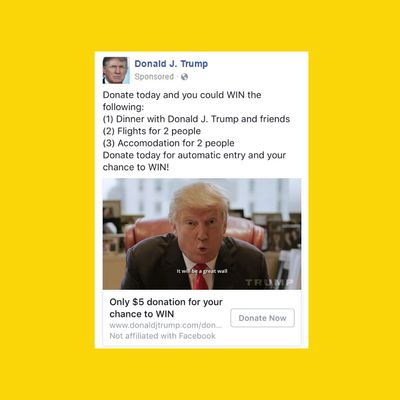
Last week, when Robert Mueller indicted more than a dozen employees from the Internet Research Agency, a Russian “troll farm,” he effectively endorsed the already widely accepted allegation that Russian actors used social media to influence the 2016 presidential election. The effectiveness of these particular efforts is up for debate (the amount of money Russians spent on ads is negligible), but as Antonio García Martínez, the architect of Facebook’s ad platform, writes in Wired, the effectiveness of the overall platform is not.
The ad auction system, he explains, is flawed at its very core, providing incentives for content that boosts engagement regardless of how. García Martínez writes:
During the run-up to the election, the Trump and Clinton campaigns bid ruthlessly for the same online real estate in front of the same swing-state voters. But because Trump used provocative content to stoke social media buzz, and he was better able to drive likes, comments, and shares than Clinton, his bids received a boost from Facebook’s click model, effectively winning him more media for less money. In essence, Clinton was paying Manhattan prices for the square footage on your smartphone’s screen, while Trump was paying Detroit prices. Facebook users in swing states who felt Trump had taken over their news feeds may not have been hallucinating.
In other words, Trump triggered a feedback loop that showed his ads to more people, and because more people saw those ads, he got a better CPM (cost per mille, or thousand) rate. The campaign did this using “provocative” ads, which is not a precise term but, knowing the demeanors of both candidates, seems correct — Clinton was trying to make policy arguments; Trump was trying to get people mad at Clinton.
While traditional media like television and radio offer political-ad rates that usually hold steady for opposing candidates, the internet faces no such regulations. As Brad Parscale, in charge of buying Facebook ads for Trump’s campaign, said on Twitter, “I bet we were 100x to 200x [less expensive that] her. We had CPMs that were pennies in some cases. This is why @realDonaldTrump was a perfect candidate for FaceBook.”
The difference in ad rates can be explained in part by the content of ads posted, and by the fact that Facebook’s high-speed automated system targets unique audiences each time. A TV station that runs opposing ads within an hour of each other will reach functionally similar audiences, but Facebook ad campaigns weigh a myriad of factors (location, age, tax bracket) that could cause some campaigns to cost far more than others.
The main point is this: The disparity in ad rates between political campaigns is a feature, not a bug; it makes Facebook boatloads of money; and the techniques Trump used in the past will continue to be used in the future. The next election cycle could be generated by whoever is the best at generating Facebook clickbait.





























